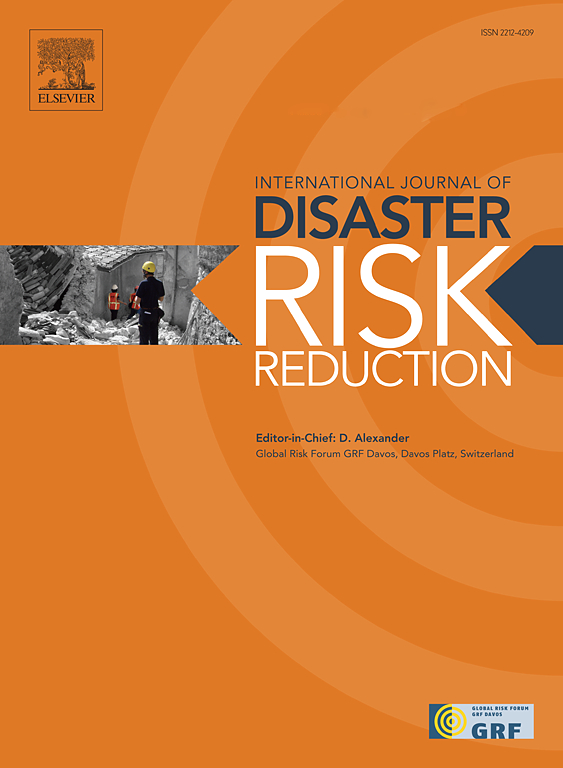Future climate risks to world cultural heritage sites in Spain: A systematic analysis based on shared socioeconomic pathways
IF 4.2
1区 地球科学
Q1 GEOSCIENCES, MULTIDISCIPLINARY
International journal of disaster risk reduction
Pub Date : 2024-09-30
DOI:10.1016/j.ijdrr.2024.104855
引用次数: 0
Abstract
Rapidly advancing anthropogenic climate change is a severe threat to cultural heritage worldwide. World cultural heritage sites (WCHS) are recognized by UNESCO as having outstanding international importance. Identifying and quantifying the impacts of climate change on the WCHS is therefore crucial for the development of long-term protection policies. Spain, the subject of the present study, is one of the most important world heritage countries in terms of the number of sites and is highly vulnerable to climate change under global scenarios.
This study identified the main climate risks faced by Spain's WCHS on the basis of future climate data from four shared socioeconomic pathway (SSP) scenarios under the most recent version of the Coupled Model Intercomparison Project (CMIP6), the most up-to-date global climate model available. Risks include sea level rise and coastal flooding, fire risk and drought risk, hydrodynamic scouring and corrosion, and biodegradation. Some WCHS are located in regions that are projected to experience surface warming exceeding the global average by 2100 under the SSP5--8.5 scenario, with a doubling of extreme climate risk (a gradient from scenarios SSP1--2.6, SSP2--4.5, SSP3--7.0 to SSP5--8.5). Under this shared socioeconomic pathway, three Spanish WCHS are at risk of being submerged by seawater by 2100. On the basis of historical data, we identified greater potential fire risk in regions where Spain's WCHS is located than in other regions in Europe, with eight WCHS experiencing weather-induced fire hazards exceeding 95 %. Considering the combination of LUC types within the Spanish WCHS, we identified two WCHS that exemplify this risk: 1) the archaeological site of Atapuerca, which is primarily occupied by broad-leaved forest, and 2) the Caliphate city of Medina Azahara, which is surrounded by natural grasslands, emphasizing the need for fire prevention in woodland and grassland areas. Furthermore, we quantified the hydrodynamic scouring risk, corrosion and biodegradation risk, and drought risk in the entire region where Spain's WCHS are located from 2081 to 2100 and clustered them on the basis of risk characteristics. We found that under the SSP1-2.6 scenario, the overall pattern of climate risk faced by Spain's WCHS did not change significantly from the present, but there were clear changes under the SSP5-8.5 scenario. We also identified that Spain's WCHS listings are at greater risk from different climate risks. This study predicts the potential impact of climate change on Spain's WCHS, emphasizing the crucial role of “carbon neutrality” in reducing various climate risks to Spain's WCHS and providing guidance for the development of future long-term protection policies.
西班牙世界文化遗产地未来面临的气候风险:基于共同社会经济路径的系统分析
快速发展的人为气候变化严重威胁着全世界的文化遗产。世界文化遗产地(WCHS)被联合国教科文组织认定为具有突出的国际重要性。因此,识别和量化气候变化对世界文化遗产的影响对于制定长期保护政策至关重要。本研究的对象国西班牙是世界遗产数量最多的国家之一,在全球气候变化的情况下极易受到影响。本研究根据现有最新全球气候模型 "耦合模型相互比较项目(CMIP6)"最新版本下的四种共享社会经济路径(SSP)情景的未来气候数据,确定了西班牙世界遗产面临的主要气候风险。风险包括海平面上升和沿海洪水、火灾风险和干旱风险、流体动力冲刷和腐蚀以及生物降解。在 SSP5--8.5 情景下,预计到 2100 年,一些世界遗产中心所在区域的地表升温将超过全球平均水平,极端气候风险将增加一倍(从 SSP1--2.6、SSP2--4.5、SSP3--7.0 到 SSP5--8.5 情景的梯度)。在这一共同的社会经济路径下,到 2100 年,西班牙的三个世界遗产将面临被海水淹没的风险。根据历史数据,我们发现西班牙世界遗产中心所在地区的潜在火灾风险高于欧洲其他地区,其中有 8 个世界遗产中心的天气引起的火灾危险超过 95%。考虑到西班牙世界遗产中心内各种土地利用变化类型的组合,我们发现有两个世界遗产中心体现了这种风险:1)阿塔普尔卡考古遗址,该遗址主要被阔叶林占据;2)哈里发城市麦地那-阿扎哈拉,该城市周围是天然草地,强调了在林地和草地地区防火的必要性。此外,我们还量化了 2081 年至 2100 年西班牙水利工程所在整个地区的水力冲刷风险、腐蚀和生物降解风险以及干旱风险,并根据风险特征对其进行了分组。我们发现,在 SSP1-2.6 情景下,西班牙水处理中心所面临的气候风险总体模式与目前相比没有显著变化,但在 SSP5-8.5 情景下则有明显变化。我们还发现,西班牙世界遗产名录面临的不同气候风险更大。本研究预测了气候变化对西班牙世界遗产中心的潜在影响,强调了 "碳中和 "在降低西班牙世界遗产中心面临的各种气候风险方面的关键作用,并为制定未来的长期保护政策提供了指导。
本文章由计算机程序翻译,如有差异,请以英文原文为准。
求助全文
约1分钟内获得全文
求助全文
来源期刊

International journal of disaster risk reduction
GEOSCIENCES, MULTIDISCIPLINARYMETEOROLOGY-METEOROLOGY & ATMOSPHERIC SCIENCES
CiteScore
8.70
自引率
18.00%
发文量
688
审稿时长
79 days
期刊介绍:
The International Journal of Disaster Risk Reduction (IJDRR) is the journal for researchers, policymakers and practitioners across diverse disciplines: earth sciences and their implications; environmental sciences; engineering; urban studies; geography; and the social sciences. IJDRR publishes fundamental and applied research, critical reviews, policy papers and case studies with a particular focus on multi-disciplinary research that aims to reduce the impact of natural, technological, social and intentional disasters. IJDRR stimulates exchange of ideas and knowledge transfer on disaster research, mitigation, adaptation, prevention and risk reduction at all geographical scales: local, national and international.
Key topics:-
-multifaceted disaster and cascading disasters
-the development of disaster risk reduction strategies and techniques
-discussion and development of effective warning and educational systems for risk management at all levels
-disasters associated with climate change
-vulnerability analysis and vulnerability trends
-emerging risks
-resilience against disasters.
The journal particularly encourages papers that approach risk from a multi-disciplinary perspective.
 求助内容:
求助内容: 应助结果提醒方式:
应助结果提醒方式:


